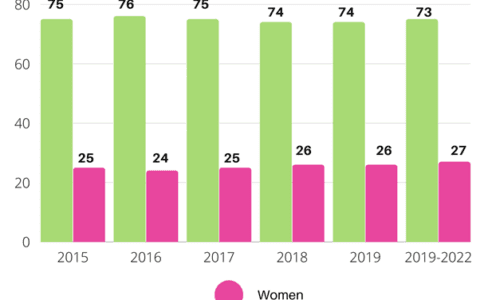Is Gendered Language Turning Candidates Away?

At some point in our working lives we have all probably used gendered words in the workplace. No matter how well-intentioned you may be, there are so many deeply ingrained phrases, titles and ‘business’ terms that are inherently gendered.
Have you ever said phrases like, ‘hi guys’, ‘manpower’, ‘man up’, or automatically referred to someone as he or she? This type of language might seem harmless, but it is actually reinforcing gender stereotypes and can be very damaging.
What is gender-neutral language?
Gender-neutral language, also referred to as gender-inclusive language, can be defined as “speaking and writing in a way that does not discriminate against a particular sex, social gender or gender identity, and does not perpetuate gender stereotypes.”
The problem with gendered language
Historically, many jobs were traditionally for either men or women, and titled accordingly – policeman, fireman, stewardess, actress. However, now that these jobs can be performed by either men or women, gender neutral alternatives are used – police officer, fire fighter, flight attendant, actor. This may seem simple, but in fact it can help anyone envision themselves in these roles, rather than it being stuck with a stigma.
However, these stereotypes of the kind of jobs men and women can or should do remain deeply rooted in language and culture. A number of studies have shown that when we hear generic masculine terms like “man “and “mankind”, that are also supposed to include women and non-binary people, we exclusively picture men. Similarly, if you were asked to picture a nurse helping a patient, the majority of people would picture a woman. Almost half of farmers in developing countries are women, however, farming is still widely considered to be men’s work.
Language expert Stan Carey highlights that “phrases like man’s origin and modern man overlook women’s contributions to civilisation; man-made and man as a verb downplay women’s labour.” This is a problem as it means we are subconsciously giving men credit for humanity’s achievements, picturing men and never women, therefore downplaying women’s contributions to society and limiting their future contributions.
The workplace can be a minefield for gendered language, with people using terms like businessman, man to man, man power, and chairman. It’s important that we actively replace these outdated phrases with gender neutral terms like business people, face to face, personnel or labour, and chair or chairperson.
Gendered neologisms
Alongside the old fashion gender stereotypes in the workplace, there are also new words and phrases being created that have tried to counteract gendered language or words that are now overtly masculine.
These new gendered neologisms include SheEO, Girlboss, mansplaining, mumtreprenuer, and many more. But are they really helpful when working towards an equal and inclusive working environment?
They started out as more tongue in cheek phrases, used to highlight the fact that commonly used words such as CEO and boss are no longer gender neutral, but implicitly coded as male. As feminist Dale Spencer argues, this language is “man-made” and reinforces a “male world view.”
However, many are now starting to argue that the meanings of these words have gotten lost along the way. On Instagram there are now over 24.3 million posts tagged with the hashtag #girlboss. It appears to have become a cutesy girl-power phrase that is no longer empowering, but actually patronising. As Guardian writer Arwa Mahdawi argues, these phrases “no longer tear down the sexism encoded in language, they reinforce it.”
‘Words such as ‘girlboss’ and ‘manspreading’ have gone from making an important point to reinforcing the differences between men and women.’
Gender neutral language in the workplace
The first point of contact between employer and employee is usually the job advert. Research has shown that when ads are gender neutral or reverse biased, jobs that are generally underrepresented by women are more likely to receive applications from women. For example, employers should use ‘server’ or ‘waiting staff’, rather than ‘waitress’.
Research conducted by Total Jobs found that just one fifth of job adverts were ‘gender neutral’. They also found that women are less likely to apply for roles where the words ‘competitive’, ‘ambitious’, or ‘dominant’ are used. However, female-coded words such as ‘support’, ‘care’ and ‘commit’, are not as off putting to men, but are more appealing to women, according to the studies.
He/She/They
When we are in the workplace, it’s important to never assume someone’s gender. A person’s name, their clothing, or any other outward signals don’t necessarily tell you how they identify. Being misgendered can be extremely hurtful, and it shows a huge lack of respect.
For people who identify as non-binary, the workplace can be a scary and stressful place. One report found that 42% of non-binary employees suffer from negative experiences in the workplace.
Making more use of ‘they’ can be hugely useful if you are unsure about someone’s pronouns. Many companies have started to swap out old fashioned gender stereotypes, for example in 2019, EasyJet swapped out its formal greeting of: “hello ladies and gentlemen” to “welcome everyone”. They have stated that they are a company that champions culture and inclusivity and encourage others to move to a gender-neutral format to remove any potential discrimination.
Breaking deeply ingrained habits will always be challenging and take time, but if we are striving for a truly diverse and inclusive working environment, everyone needs to change and adapt. Using gender-neutral language is about questioning your assumptions, considering the sexist notions that contributed to these speech patterns in the first place, and doing your part to break the loop. It’s about paying attention to signs of underlying sexism and acting against them, rather than dismissing them and saying, “it’s just an expression.”
STEM Women
At STEM Women, we are passionate about addressing the gender imbalance in STEM. We host regular networking and careers events for people who identify as women or non-binary and are looking to start their careers in a STEM industry.
In 2020, women accounted for just 24% of the core STEM workforce. Overall estimates suggest that LGBTQ+ people are roughly 20% less represented in STEM fields than expected, with figures for people who identify as non-binary extremely difficult to find.
Our events allow underrepresented groups to find their dream roles in industries that were historically dominated by white, straight men.
During our events, attendees can network live with recruiters, hear inspiring talks from women working in STEM and ask their questions during insightful panel sessions.
If you would like to attend any of the STEM Women events, please register your interest on our virtual event platform.
For employers looking to exhibit at one of our events, please get in touch with Event Sales Manager, Lauren Jenkins at laurenj@stemwomen.co.uk.







